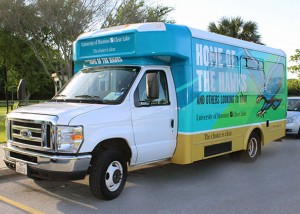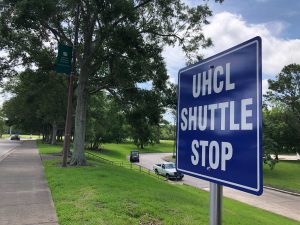
EDITORIAL: UHCL shuttle service failures hinder student success and safety
On June 5, UHCL Parking and Transportation announced it would no longer provide shuttle service to five apartment complexes located on Bay Area Boulevard. A month later, on July 6, UHCL Parking and Transportation sent out an email saying the shuttle would instead stop at centralized locations.
As addressed in a June 27 article, a miscommunication error led to the June 5 announcement. For the students who use the shuttle service, a question arose concerning how the loss of service would impact their health and safety.
Those who utilize the shuttle service do so for a variety of reasons beyond transportation to and from the apartment complexes. Students use the shuttle to travel to and from on-campus jobs and for weekly grocery trips.
Shuttle service miscommunications

The university’s shuttle system, which is currently operated by University Parking and Transportation, is often experiencing temporary suspensions because of a lack of people who can drive the shuttle and operational issues with the shuttle itself. This causes either downtimes during the day where there is no shuttle at all or a white van is assigned to be the “temporary” form of transportation.
Whenever the shuttle service is temporarily suspended, the University Parking and Transportation sends out an email to the UHCL students that informs those who do read their emails that the service has been suspended temporarily, often without giving an estimated time when the shuttle service will be up and running again. These emails can sometimes come without much advance notice and not all UHCL students frequently check their UHCL email accounts.
It is understandable driver and mechanical issues could lead to a temporary suspension of the shuttle service, however, only sending out emails is not enough. Students who do not have access to WiFi or a smartphone are left completely unaware of the changes and must rely on their friends or word-of-mouth to inform them about changes in the shuttle.
This is inappropriate on the university’s behalf, as students should not be tasked as a university’s messenger for others who do not have access to—or can afford—instantaneous messaging reliant on WiFi and smartphones.
When the shuttle service is canceled students must decide whether or not to use a rideshare app, like Uber or Lyft, or make the uncomfortable trek to campus. The rideshare option is costly, with the expense usually between $7 and $10 one way. However, in July and August, walking the approximate 45 minutes from the university to the apartment complexes is not feasible considering the high heat index and unpredictable Houston weather. During the summer months, heavy rainfall happens almost every week and the heat indexes reach over 100 degrees Fahrenheit.

Since the shuttle system is used primarily by international students who live in the apartment complexes on Bay Area Boulevard, it is those students who are most affected by the shuttle service changes. Because of employment restrictions, international students often work on-campus jobs and cannot afford numerous rideshare trips or a transportation vehicle.
UHCL has a duty to students that the promised transportation is always available, even if there is an issue with a driver or the shuttle bus. The money used to fund the shuttle system comes out of the fees students provide when they enroll at the university. The Student Fee Allocation Committee gives UHCL Parking and Transportation approximately $60,000 a year to operate the shuttle service. Not giving the students the services they paid for and employing unreliable communication tactics is a gross misuse of these student fees.
While living on campus at the upcoming residence hall or at University Forest Apartments is a solution, it is not the best option for all students. On-campus living is a large expense and off-campus housing can be more cost-effective. Coupled with the costs of transportation to and from the university and the fact international students pay higher tuition, housing on or off-campus is incredibly expensive. International students cannot afford for their student fees to not be allocated in a way that serves them the best.
Other communicative options
Even though the university has a shuttle route schedule available on its website, there is no way, under the current system, students can rely on the shuttle 100% of the time. With a limited number of drivers and one active shuttle bus running at a time, there is ample opportunity for suspension of service to occur—and it frequently does.
While the University Parking and Transportation emails do work for some students, it does not provide enough communication between the university and the students.
In addition to the emails, the university could send out text messages or automated phone calls to students who sign up for emergency notifications from the University Parking and Transportation. These text messages and phone calls would reach the students who do not have a smartphone.
Another option would be to have signs posted at the various bus stop locations with a number students can call or text to figure out the best way to make it to class or work on time without a penalty for being late.
There could also be notifications posted on the TV screens around campus and displayed on computer screensavers in the various labs on campus.
The university could also start posting on social media platforms more often about the shuttle service when it becomes “temporarily suspended.” Even if students do not have smartphones, a lot will still check social media platforms on laptops or computers.
Students also rely on communication from student organizations on campus to stay informed. Working with the student orgs to help create tailored messages to students should also be an option.
The shuttle service’s “temporary suspensions” is just another recent example in a number of ways the university is using ineffective communication in order to reach its students.
The issue is UHCL treats all of its students like a middle-class traditional student who has access to ample technology and funds. By investing time and energy into making sure all students are receiving the same communication, UHCL can become a more friendly campus for all of its students.
